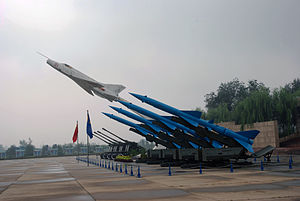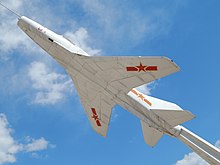Nanchang J-12
| Nanchang J-12 | |
|---|---|
 Nanchang J-12 in the Chinese Aviation Museum , Beijing |
|
| Type: | Fighter plane |
| Design country: | |
| Manufacturer: |
Nanchang Aircraft Mfg. Co. |
| First flight: |
December 26, 1970 |
| Number of pieces: |
3 + 6 (?) |
The NAMC-J-12 (Chinese: 歼 -12;) was a light supersonic fighter aircraft that was built in the People's Republic of China for the Air Force of the People's Republic of China (PLAAF).
history
The Nanchang J-12 was one of the first serious attempts by the Chinese aviation industry to develop its own modern jet fighter. With a curb weight of 3,172 kg, the J-12 is one of the lightest fighter jets ever built.
In 1969, the PLAAF published a requirement for a small, light, and inexpensive STOL fighter aircraft to replace the MiG-19 . Two designs were submitted, the Shenyang J-11 (not to be confused with the Shenyang J-11 Flanker B + , which entered service in 1998) and the Nanchang J-12, but neither model reached production readiness.
The shape of the J-12 was designed by Lu Xiao Peng and three prototypes were built by the Nanchang Aircraft Manufacturing Company (NAMC). The flight tests began on December 26, 1970 and yielded disappointing performance data, which is why further prototypes were built with improvements such as simplified control surfaces, streamlined fuselage shape and revised air intake, which were visually very similar: small, single-seat jet fighters with low-set swept wings , swept control surfaces, and tubular fuselage and a bow air inlet with small or nonexistent inlet cones. In 1977, development of the J-12 was abandoned, likely because the Chengdu J-7 , based on the Soviet MiG-21F , offered superior performance and was built on proven technology. The main problems of the J-12 were insufficient firepower and insufficient engine thrust. The J-12 completed 135 flights with 61 flight hours by 1977. Presumably nine J-12s were built.
In the 1990s, Lu Xiao Peng proposed a modernization of the J-12 with a reduced radar cross section to make it more difficult to detect by radar ; also a version as a carrier-based fighter for the Chinese Navy . None of the proposals were implemented.
Technical specifications
| Parameter | Data |
|---|---|
| crew | 1 |
| length | 10.3 m |
| span | 7.2 m |
| height | 3.73 m |
| Wing area | 16.0 m² |
| Empty mass | 3,172 kg |
| Takeoff mass | 4,530 kg |
| Top speed | 1,300 km / h |
| Climb performance | 10,800 m / min |
| Service ceiling | 16,970 m |
| Operational range | 688 km |
| Engines | 1 × Turbojet Wopen WP-6Z with afterburner |
| Standing thrust | 2,500 kg |
| Thrust with afterburner | 4,050 kg |
| Armament |
|
See also
literature
- Jefim Gordon , Dmitri Komissarow: Chinese Aircraft . Hikoki Publications, Manchester 2008, ISBN 978-1-902109-04-6 , pp. 267 .
Web links
- Airwar.ru (Russian)
- Images of preserved J-12s at Airliners.net
- J-12 and J-XX at Globalsecurity.org
- J12 fighter photos and introduction (chinese)
Individual evidence
- ↑ China Today: Aviation Industry . China Aviation Industry Press, 1989.
- ^ J12 fighter stealth modification . In: AirForceWorld.com . Archived from the original on June 17, 2017. Retrieved November 15, 2016.
